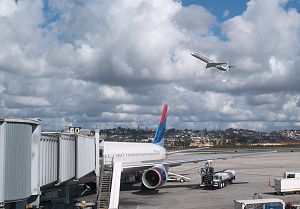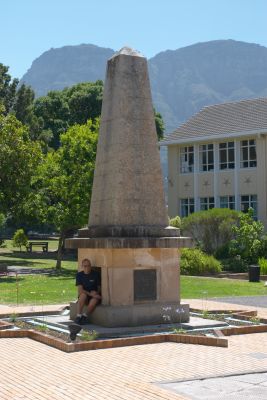| ||||||||||||||||||
| ||||||||||||||||||
FYI: My friend and fellow eclipse chaser "Klipsi" is posting daily updates from the icebreaker expedition.
Waiting to board my plane...

The Salton Sea in the Southern California Desert, with farms fed by Colorado River water.

My hotel room in Atlanta.



This is the 737-800 plane we took from JoBurg to CPT, on the tarmac at Cape Town. No fancy jetways here!

I have now met up with several other members of the group. More are trickling into the hotel throughout the day. I picked up my Antarctic cold weather kit, which includes a ton of stuff including sleeping bag, folding chair, plate and utensils, plenty of reading material, and various cold weather clothes. I'll try to post pictures after I recover from my jetlag. Coming up tomorrow are tours of Cape Town and our orientation and briefings.

We left the hotel at about 9:30am and headed up to the Table Mountain cableway. It was a beautiful day, with no wind at the top.

I forgot to put on my suntan lotion and got a light sunburn on my face! We saw many lizards and some rock rabbits, and AMAZING panormaic views.

Where's the Moon? Vic Winter already found it and had moved on...

In the afternoon David Levy gave a talk about his inspirations for astronomy, some thoughts on eclipses, and his comet-hunting experiences. Here is a photograph of the comet he codiscovered (Shoemaker-Levy 9), the comet that crashed into Jupiter in 1994. The image on the right is blurred because it was taken during the Northridge earthquake.

Next, Brian Warner (a Capetonian astrophysicist) gave a talk about the Sun's magnetic goings-on and what to expect at this eclipse.

That was followed by the safety and protocol briefings. Scared me silly ("in the event of a cabin depressurization the cabin crew will distribute oxygen masks" - um, at 30,000 feet you'll be dead by the time they START giving them out). Apparently we had a colder than normal winter, so there is more ice. The AN2 biplanes we will be flying were partially buried by blowing snow. Below in front looking at me is Vasiliy Kaliazin, one of the ALCI (Antarctic Logistics Company Intl) head honchos. To the left in white shirts are our pilots.

Below is a map of the area we will visit.


Next we went to the Cape Peninsular National Park, at the southwestern tip of Africa. The end of Africa.

Last we went to the Simonstown penguin colony.


The scenery was beautiful.

We got all packed up, but at the last minute today's flight to Antarctica was postponed. Seems there is a fierce storm raging through the area. The advance camp workers are holed up in their tents eating emergency rations, conditions are too poor to walk the 50 meters to the mess tent. That certainly means a plane can't land! Our eclipse site infrastructure (toilets, coffee tent, windbreaks) have been blown away. Weather is improving and we should be able to put in tomorrow (Saturday). The remaining schedule has been rearranged accordingly, if it goes according to plan we have 18 hours between hitting the ice and the eclipse.

It's now a library and office building, the domes and telescopes were removed long ago. Brian Warner gave us a fascinating VIP tour of the place.

One of the displays in the observatory's museum detailed the Shoemaker-Levy 9 comet which was co-discovered by and named after a member of our group. David Levy had to wait and let everyone take his picture with the display!

Next we went into one of the remaining domes and examined the telescopes.

After that we went to a schoolyard to see the Herschel monument, which marks the exact spot where John Herschel's telescope was located. It is where some of the most important and lasting southern-hemisphere discoveries were made. Amateur astronomers like me use the data gathered at this site almost every time we observe the southern sky. It was hot out: 93F/34C, if we fly to Antarctica tomorrow that will be a 100 degree F change in 24 hours.

To finish it all up we stopped at the South Africa Museum Planetarium for a talk on African astronomy (from ancient to state-of-the-art). We also got a preview of what the stars and planets will look like during the eclipse, which will be a big help during eclipse totality.

At the 6pm weather briefing there was good news and bad news.

The bad news is that the sandwiches packed for us to eat in Antarctica are going to get more stale: the flight down has been delayed by 4-12 hours. Our day-and-a-half weather buffer time is now down to three hours. The leaders are getting hourly weather updates and we will be awakened in the night if the weather improves earlier than expected. Today the temperatures were down to -18F (-28C) with 60mph (100kph) winds. Three of the sleeping tents blew down. The news from our icebreaker friends (another eclipse trip) was also bad: the seas are very rough, everyone is seasick, they are abandoning their plans and running away from the storm. It will be a miracle if they see the eclipse.
 Not eclipse related, but still interesting to me: California's largest ever wildfire, known as the "Cedar" fire, burned 280,278 acres (1,134 sq. km) of San Diego backcountry a few days ago. My home came within yards (meters) of being burned. This true-color satellite image shows the massive areas that burned near San Diego. I have outlined them in faint red to show the charred areas that are now black with ash and burnt brush. The green star is where my home is.
Not eclipse related, but still interesting to me: California's largest ever wildfire, known as the "Cedar" fire, burned 280,278 acres (1,134 sq. km) of San Diego backcountry a few days ago. My home came within yards (meters) of being burned. This true-color satellite image shows the massive areas that burned near San Diego. I have outlined them in faint red to show the charred areas that are now black with ash and burnt brush. The green star is where my home is.
 This image gives a very rough approximation of what the corona will look like during the eclipse. It was taken half a Sun-rotation before the eclipse, so by mirror-imaging it and reorienting it for Southern Hemisphere viewing we can get an idea of what to expect. Image courtesy the SOHO spacecraft's LASCO C2 instrument and the Naval Research Laboratory.
This image gives a very rough approximation of what the corona will look like during the eclipse. It was taken half a Sun-rotation before the eclipse, so by mirror-imaging it and reorienting it for Southern Hemisphere viewing we can get an idea of what to expect. Image courtesy the SOHO spacecraft's LASCO C2 instrument and the Naval Research Laboratory.
 This is a view of the Novo / basecamp area a week and a half before the eclipse, courtesy the MODIS Rapid Response Project. The resolution is 250 meters per pixel, so this view is 65km (40mi) wide.
This is a view of the Novo / basecamp area a week and a half before the eclipse, courtesy the MODIS Rapid Response Project. The resolution is 250 meters per pixel, so this view is 65km (40mi) wide.
Here is my tentative itinerary, subject to alterations due to weather:
|
| ||||||||||||||||||||||||||||||||||||||||||||||||||||||||||||||||||||||||||||||||||||||||||||||||||
| |||||||||||||||||||||||||||||||||||||||||||||||||||||||||||||||||||||||||||||||||||||||||||||||||||
Please visit the main page first for background information. If you've already read it, then instead please visit my main astronomy page, or check out my homepage.
All text and images are © 2003 Manfred Bruenjes - All Rights Reserved. Image inlining (aka hot linking) and framing are strictly prohibited. Email for permission before using an image or text.